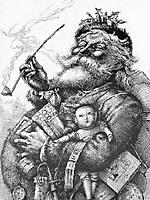 I can remember my Mother telling me that, as I'm sure most of you can too. We all know Santa as the familiar image with his red suit, sled or sleigh, reindeers, and sacks of toys delivering packages to "all the good girls and boys!" I love the Christmas season and I always have. It is by far one of my favorite times of the year.
I can remember my Mother telling me that, as I'm sure most of you can too. We all know Santa as the familiar image with his red suit, sled or sleigh, reindeers, and sacks of toys delivering packages to "all the good girls and boys!" I love the Christmas season and I always have. It is by far one of my favorite times of the year.The familiar image of Santa Claus is an American invention that first appeared in a drawing by Thomas Nast in Harper's Magazine in 1868 (see picture on the right).
 Thomas Nast helped create the kinder, more fatherly, plumper Santa as we know him today. But, Thomas Nast wasn't the only person to contribute to this legend. Clement Clarke Moore was a huge contributor as in 1822 he published his poem "A visit From St. Nicholas," bittern known as "The Night Before Christmas." His poem is the first mention of a sleigh powered by "eight tiny reindeer" and mentioning their names.
Thomas Nast helped create the kinder, more fatherly, plumper Santa as we know him today. But, Thomas Nast wasn't the only person to contribute to this legend. Clement Clarke Moore was a huge contributor as in 1822 he published his poem "A visit From St. Nicholas," bittern known as "The Night Before Christmas." His poem is the first mention of a sleigh powered by "eight tiny reindeer" and mentioning their names. The legend of Father Christmas, however, is ancient and far more complex. Part of the legend is attributed to St. Nicholas and part to a jovial medieval figure in the "Spirit of Christmas." In Russia, Father Christmas carries a piglet under one arm. St. Nicholas is also know as Santa Claus, Father Christmas, Heilige Nikolaus, and Pere Noel.
The legend of Father Christmas, however, is ancient and far more complex. Part of the legend is attributed to St. Nicholas and part to a jovial medieval figure in the "Spirit of Christmas." In Russia, Father Christmas carries a piglet under one arm. St. Nicholas is also know as Santa Claus, Father Christmas, Heilige Nikolaus, and Pere Noel.In the early part of the 19th century there was a revival of a Viking tradition of a jovial, winter figure who was associated with the winter festival. He was referred to as the "Spirit of Christmas." It was believed that by inviting him in through the "front door" to join in your holiday feasting, that the winter would be kind. The "Spirit of Christmas" was subsequently renamed "Father Christmas". Instead of him visiting through the front door, his visits were to be a surprise, with him arriving during the night and down the chimney. Victorian children would write letters to him and then throw them into the fireplace. Why burn the letters? Because, my dear, Father Christmas can read smoke.
But, where did St. Nicholas really come from? It is said that St. Nicholas was born in 245 A.D. in Patara near Fethiye and died in 326 A.D. having spent his life in Anatolia (which I believe is in Turkey.) St. Nicholas was the son of a wealthy family and had a good education. He became the Bishop of Demur, trying to solve the problems of his people in a most humane way. He devoted himself to mankind. He was known as the protector of children and sailors. In a number of countries the death of St. Nicholas is commemorated by the giving of presents to children.
But, how did the legend really begin? Well, it is said that St. Nicholas heard of a family with three daughters who were unable to wed as they had no dowry. St. Nicholas had come from a wealthy family and had given up all his worldly possessions to become a bishop. He took 3 bags of gold coins and dropped them down the family's chimney. The coins landed in the girls stockings that had been hung to dry on the fireplace (ah, that's where stockings come from!) St. Nicholas was caught in the act by the girls father, but he begged him to keep his secret. Two days later, however the entire village heard of his gift and so the tradition of stockings and St. Nicholas began.
In 1951-1955 St. Nicholas became synonymous with Santa Claus and in 1955 a Father Christmas stamp was issued. St. Nicholas devoted his life to his love of humanity, love for people of all different religions and beliefs. Most of all, his love for peace, friendship, and brotherhood.
Santa Claus, Father Christmas, or St. Nicholas is also a favorite of all crafters and doll makers. Why? Because we can make him anything we want him to be. Jovial, fat, skinny, Victorian, woodland, primitive, ugly. It doesn't matter. We love them all. Well, at least I do.
So, this Christmas season when you are hurrying around to get everything done and are fighting the crowd of shoppers just remember that St. Nicholas's message is one of peace, love, and humanity. Slow down, take a breath, and enjoy the season. And, remember these words from a very old, wise, good man: "Ho! Ho! Ho! Merry Christmas!"

No comments:
Post a Comment